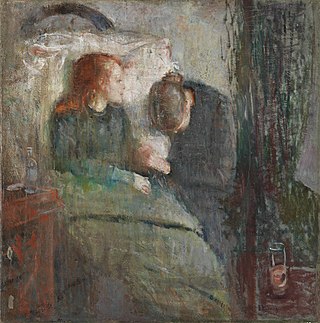
Edvard Munch was a Norwegian painter. His 1893 work, The Scream, has become one of Western art's most acclaimed images.

Munch Museum, marketed as Munch since 2020, is an art museum in Bjørvika, Oslo, Norway dedicated to the life and works of the Norwegian artist Edvard Munch.

The Scream is a composition created by Norwegian artist Edvard Munch in 1893. The Norwegian name of the piece is Skrik (Scream), and the German title under which it was first exhibited is Der Schrei der Natur. The agonized face in the painting has become one of the most iconic images of art, seen as symbolizing the anxiety of the human condition. Munch's work, including The Scream, had a formative influence on the Expressionist movement.

Madonna is the usual title given to several versions of a composition by the Norwegian expressionist painter Edvard Munch showing a bare-breasted half-length female figure created between 1892 and 1895 using oil paint on canvas. He also produced versions in print form.
The year 1892 in art involved some significant events.
The year 1895 in art involved some significant events.

Bohumil Kubišta was a Czech painter and art critic, one of the founders of Czech modern painting. He studied at the Academy of Fine Arts in Prague, but left in 1906 to study at the Reale Istituto di Belle Arti in Florence. He, Emil Filla, Antonín Procházka, and five others founded Osma, an Expressionist-oriented group of artists.

The Sick Child is the title given to a group of six paintings and a number of lithographs, drypoints and etchings completed by the Norwegian artist Edvard Munch between 1885 and 1926. All record a moment before the death of his older sister Johanne Sophie (1862–1877) from tuberculosis at 15. Munch returned to this deeply traumatic event repeatedly in his art over a period of more than 40 years. In the works, Sophie is typically shown on her deathbed accompanied by a dark-haired, grieving woman assumed to be her aunt Karen; the studies often show her in a cropped head shot. In all the painted versions Sophie is sitting in a chair, obviously suffering from pain, propped by a large white pillow, looking towards an ominous curtain likely intended as a symbol of death. She is shown with a haunted expression, clutching hands with a grief-stricken older woman who seems to want to comfort her but whose head is bowed as if she cannot bear to look the younger girl in the eye.

Knud Larsen Bergslien was a Norwegian painter, art teacher and master artist. In his art, he frequently portrayed the lives of the Norwegian people, their history and heroes of the past. Bergslien is most associated with his historical paintings, especially Skiing Birchlegs Crossing the Mountain with the Royal Child.

Ludvig Karsten was a Norwegian painter. He was a neo-impressionist influenced by Edvard Munch, Henri Matisse and contemporary French painting. He first participated at the Autumn exhibition in Kristiania in 1901, and had his first separate exhibition in 1904. He is represented at museums in many Scandinavian cities, including several paintings at the National Gallery of Norway. Karsten was known for his bohemian lifestyle and quick temper.

Christmas in the Brothel is an oil-on-canvas painting by Norwegian painter Edvard Munch. The Expressionist painting was completed in 1903–04 and is housed at the Munch Museum in Oslo.

Model by the Wicker Chair is a 1919–1921 painting by the Norwegian artist Edvard Munch that is in the collection of the Munch Museum in Oslo.

Inger on the Beach is a painting by the Norwegian artist Edvard Munch. It was created in the summer of 1889, at Åsgårdstrand and is a portrait of Munch's youngest sister Inger.

Jappe Jacob Nilssen was a Norwegian writer and art historian.

Self-Portrait. Between the Clock and the Bed. is a 1940–1943 self-portrait painting by Edvard Munch which is one of his last major works. Munch depicts himself as an unhappy, aging man who appears frozen and flattened. Behind him is a bright room full of light and past paintings, but he has placed his current self between a clock and a bed, symbolising the inevitable passing of time and where he will eventually lie down for the final time.
Arne Kristian Eggum is a Norwegian art historian who mainly focused his scientific work on Edvard Munch.

Self-Portrait with Cigarette is an 1895 painting by the Norwegian artist Edvard Munch. Munch's use of the cigarette and physical decay as a rejection of societal values aroused controversy following the self-portrait's 1895 exhibition. As of 2021, the work is held by the National Gallery in Oslo.

Death and the Child is a composition created by Edvard Munch in 1889. Since 1918 it is located in the Kunsthalle Bremen. It depicts a little girl at her mother’s deathbed who is looking at the viewer in a fearful manner. A second, thus far unknown painting of the artist was discovered underneath the canvas in 2005. A new version of that motif, which refers to Munch’s family and the early death of his mother was created between 1897 and 1899 and is now hanging in the Munch Museum in Oslo. An etching was made in 1901 with this motif.

Inheritance is an oil painting on canvas created by the Norwegian painter Edvard Munch (1863–1944). It depicts a mother with syphilis holding her baby, who is affected by congenital syphilis. Munch completed the work after visiting the Hôpital Saint-Louis in Paris, where he saw a woman crying for her child with the disease.
















